SEWING BUDDHA'S ROBE
You start wherever you can. You see a great need, so you thread a needle, you tie a knot in your thread. You find one place in the cloth through which to take one stitch, one simple stitch, nothing fancy, just one that’s strong and true.
– Anne Lamott
Introduction:
Sewing Buddha's Robe is an offering at Appamada for those who have taken the Precepts Program or who are currently in the Precepts Program and consider Appamada their practice home. It is entirely voluntary, for those who would like to explore this traditional practice. It begins with some background reading and preparation to prepare you for sewing a rakusu, or small, five-panel version of Buddha's robe. See the topics from the original class below. Then you may join the regular Sunday afternoon sewing group at any time. Please check with Peg if you are interested.
Please also read my Reflections on the Bodhisattva Ceremony and Wearing Buddha's Robe at Appamada, and this lovely poem by William Stafford, "The Way It Is."
No previous sewing experience is necessary.
Structure of the original class series:
Class 1. Introduction and overview of sewing Buddha's Robe as mindful practice; the relationship of this practice to taking the precepts. Information about the rakusu ceremony and the way rakusus will be worn and circulated in the sangha.
Class 2. Readings from Dogen, Shohaku Okumura, and Diane Riggs on the significance and meaning of sewing Buddha's Robe.
Class 3. Planning for sewing: Architecture of a rakusu, diagrams, process, how to measure and mark the pattern, how to properly cut the fabric.
Class 4. Learning the stitches, pinning and practice sewing, and finally cutting pieces and preparing for sewing a rakusu.
At the end of the class students have the instructions and the materials prepared for sewing a rakusu (a rakusu "kit"), and may join the sewing group as their schedule permits. If you are not able to join the sewing group on Sundays, we will work out alternative ways for you to meet with others for sewing.
Sewing practice group:
The sewing practice group participants will be at different stages of sewing Buddha's robe. The space and time for sewing is Sunday afternoons from 4:00-5:30. The format for the sewing group: we begin with an incense offering and chanting the verse of the robe. We sew together in silence (except for questions and instructions about the work) for the first hour. Sewing practice is essentially zazen with sewing (and in comfortable chairs!) Then we will have a chance to discuss the work, ask questions, and share a bit about our experience.
Once a set of rakusus and their envelopes has been completed, there will be a ceremony of blessing, receiving and offering the rakusus. The traditional Japanese name for this ceremony is Jukai. In keeping with our relational practice and the heart of our sangha practice, we have a slightly different model for this, which Peg or a sewing teaching can explain.
Supplies needed:
What you need (some supplies can be found at local shops; others need to be ordered; many of these items can be shared):
1. A set of pins with colored round heads. Most hobby shops and fabric stores stock these.
2. A packet of needles. Sharps are preferred. Again, hobby shops and fabric stores.
3. A wristband pincushion. You can find different varieties of these. Don't get the ones that snap onto your wrist with a plastic bracelet: they scratch and become uncomfortable. The ones with a fabric strap and velcro fastener seem most comfortable and adjustable.
4. A storage box for your project: a good size is approximately 12" X 17". The Bigso Stockholm document boxes from the Container Store work well, for example, but you may use any container you wish.
5. A pair of sewing scissors. The best scissors can be quite costly (I have a pair of Shozaburo scissors from Japan that run about $70, and that is the low end of this brand), but you do not need fancy scissors. Your scissors do need to be sharp, and sewing scissors are preferred. (You can find perfectly useful sewing scissors at most craft, hobby, or fabric stores, as well as at the usual outlets such as Target, Bed Bath and Beyond, etc.) It's good to purchase them where you can try them out to be sure they fit your hands. Do not let children play with your sewing scissors, and do not use scissors that have been in household use.
6. A chalk marking pen. These come from France via Amazon and are perfect for making an even white line without sharpening.
7. A centimeter ruler at least 12" long
8. At least one spool of thread in one of the approved colors (see list to the right).
8. Silk for your envelope lining, ½ yard. A good selection can be found at thaisilks.com.
Thai Silks is located at 1959 B Leghorn St, Mountain View, CA 94043 in case you are in the neighborhood!
Useful, but not required:
Magnifying glasses for close work, if you need them. I use these Donegan Optivisors. (Mine are 1.75x Magnification, 3 Diopers, 14" Focal Length).
CONTACT:
Peg Syverson
pegsyverson@gmail.com
INSTRUCTIONS
Materials
Student Jukai rakusu:
Fabric: Moda, Bella Solids, Night Sky, color 9900 117 15 (medium blue gray)
Gutermann thread colors (available at Joann):
Gold: 823
Burgundy: 447
Silver-blue: 900
Steel gray: 112
Lavender: 930
Charcoal: 125
Dark wine: 939
Dark blue: 944
Silver: 102
Matching color: 935
Dharma Teacher Entrustment Rakusu
Dharma Transmission Rakusu
Silk backing for rakusus
White Taffeta Silk: Thaisilks.com
STUDY
REFLECTIONS

